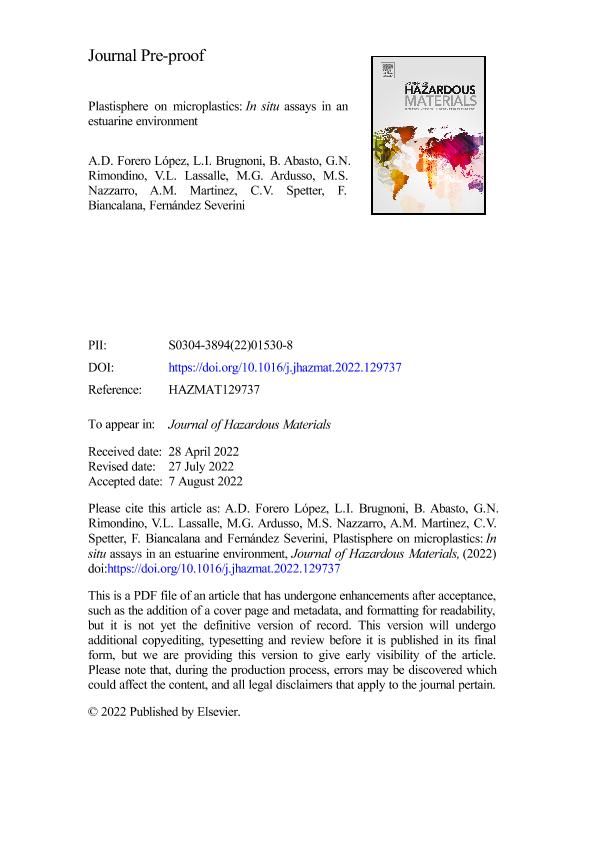Artículo
Plastisphere on microplastics: In situ assays in an estuarine environment
Forero Lopez, Ana Deisy ; Brugnoni, Lorena Inés
; Brugnoni, Lorena Inés ; Abasto, Benjamín
; Abasto, Benjamín ; Rimondino, Guido Noé
; Rimondino, Guido Noé ; Lassalle, Verónica Leticia
; Lassalle, Verónica Leticia ; Ardusso, Maialen Gisel
; Ardusso, Maialen Gisel ; Nazzarro, Marcelo Sandro
; Nazzarro, Marcelo Sandro ; Martinez, Ana María; Spetter, Carla Vanesa
; Martinez, Ana María; Spetter, Carla Vanesa ; Biancalana, Florencia
; Biancalana, Florencia ; Fernandez Severini, Melisa Daiana
; Fernandez Severini, Melisa Daiana
 ; Brugnoni, Lorena Inés
; Brugnoni, Lorena Inés ; Abasto, Benjamín
; Abasto, Benjamín ; Rimondino, Guido Noé
; Rimondino, Guido Noé ; Lassalle, Verónica Leticia
; Lassalle, Verónica Leticia ; Ardusso, Maialen Gisel
; Ardusso, Maialen Gisel ; Nazzarro, Marcelo Sandro
; Nazzarro, Marcelo Sandro ; Martinez, Ana María; Spetter, Carla Vanesa
; Martinez, Ana María; Spetter, Carla Vanesa ; Biancalana, Florencia
; Biancalana, Florencia ; Fernandez Severini, Melisa Daiana
; Fernandez Severini, Melisa Daiana
Fecha de publicación:
15/10/2022
Editorial:
Elsevier Science
Revista:
Journal of Hazardous Materials
ISSN:
0304-3894
Idioma:
Inglés
Tipo de recurso:
Artículo publicado
Clasificación temática:
Resumen
In this study, the influence of the plastisphere on metals accumulation and weathering processes of polystyrene (PSMPs) and nylon microplastics (NyMPs) in polluted waters during a 129 day-assay were studied. MPs were characterized through scanning electron microscopy (SEM) with Energy dispersive X-ray (EDX), X-ray diffraction (XRD), attenuated total reflectance Fourier transformed infrared (ATR-FTIR) spectroscopy, contact angle, and thermogravimetric analysis (TGA). Also Cr, Mn, Zn, Cd, Pb, and Cu in the plastisphere on MPs were analyzed during the assay. Potentially pathogenic Vibrio, Escherichia coli, and Pseudomonas spp. were abundant in both MPs. Ascomycota fungi (Phona s.l., Alternaria sp., Penicillium sp., and Cladosporium sp.), and yeast, were also identified. NyMPs and PSMPs exhibited a decrease in the contact angle and increased their weights. SEM/EDX showed weathering signs, like surface cracks and pits, and leaching TiO2 pigments from NyMPs after 42 days. XRD displayed a notorious decrease in NyMPs crystallinity, which could alter its interaction with external contaminants. Heavy metal accumulation on the plastisphere formed on each type of MPs increased over the exposure time. After 129 days of immersion, metals concentrations in the plastisphere on MPs were in the following order Cr ˃ Mn ˃ Zn ˃ Cu ˃ Pb ˃ Cd, demonstrating how the biofilm facilitates metal mobilization. The results of this study lead to a better understanding of the impact of marine plastic debris as vectors of pathogens and heavy metals in coastal environments.
Palabras clave:
BIOFILMS
,
HEAVY METALS
,
PATHOGENS
,
POLLUTION
,
SURFACE DEGRADATION
Archivos asociados
Licencia
Identificadores
Colecciones
Articulos(IADO)
Articulos de INST.ARG.DE OCEANOGRAFIA (I)
Articulos de INST.ARG.DE OCEANOGRAFIA (I)
Articulos(INBIOSUR)
Articulos de INSTITUTO DE CIENCIAS BIOLOGICAS Y BIOMEDICAS DEL SUR
Articulos de INSTITUTO DE CIENCIAS BIOLOGICAS Y BIOMEDICAS DEL SUR
Articulos(INFAP)
Articulos de INST. DE FISICA APLICADA "DR. JORGE ANDRES ZGRABLICH"
Articulos de INST. DE FISICA APLICADA "DR. JORGE ANDRES ZGRABLICH"
Articulos(INFIQC)
Articulos de INST.DE INVESTIGACIONES EN FISICO- QUIMICA DE CORDOBA
Articulos de INST.DE INVESTIGACIONES EN FISICO- QUIMICA DE CORDOBA
Articulos(INQUISUR)
Articulos de INST.DE QUIMICA DEL SUR
Articulos de INST.DE QUIMICA DEL SUR
Citación
Forero Lopez, Ana Deisy; Brugnoni, Lorena Inés; Abasto, Benjamín; Rimondino, Guido Noé; Lassalle, Verónica Leticia; et al.; Plastisphere on microplastics: In situ assays in an estuarine environment; Elsevier Science; Journal of Hazardous Materials; 440; 15-10-2022; 1-61
Compartir
Altmétricas



